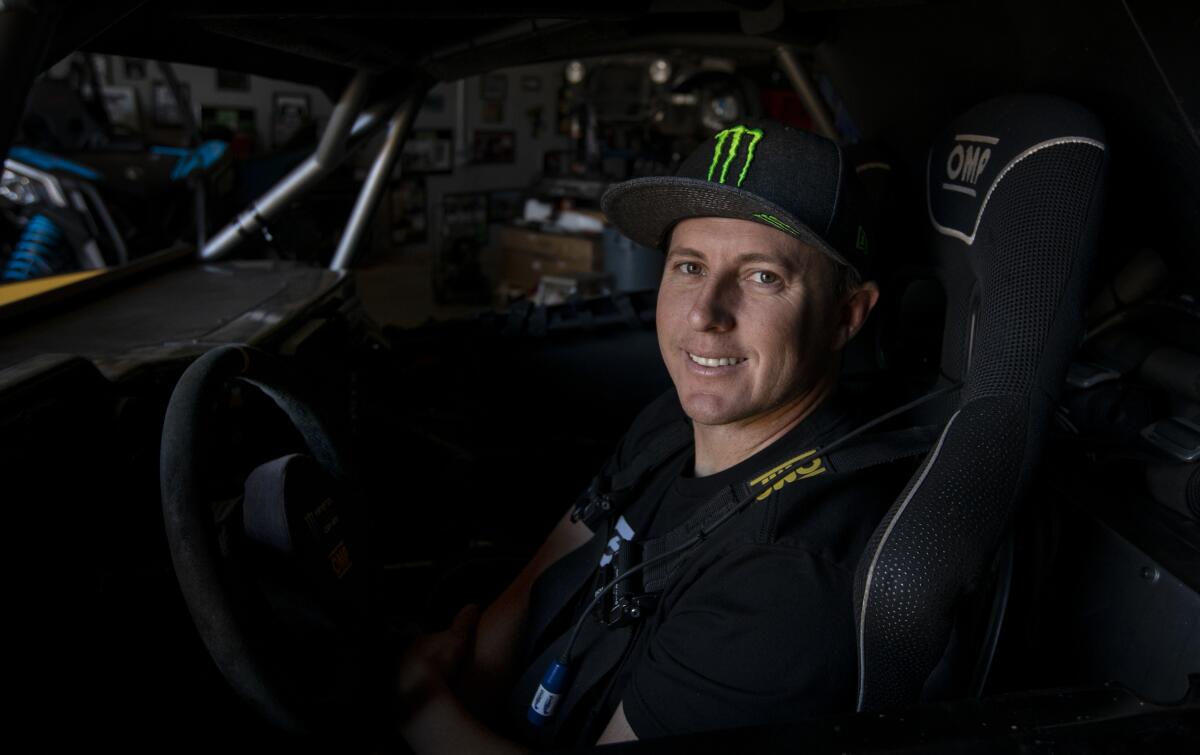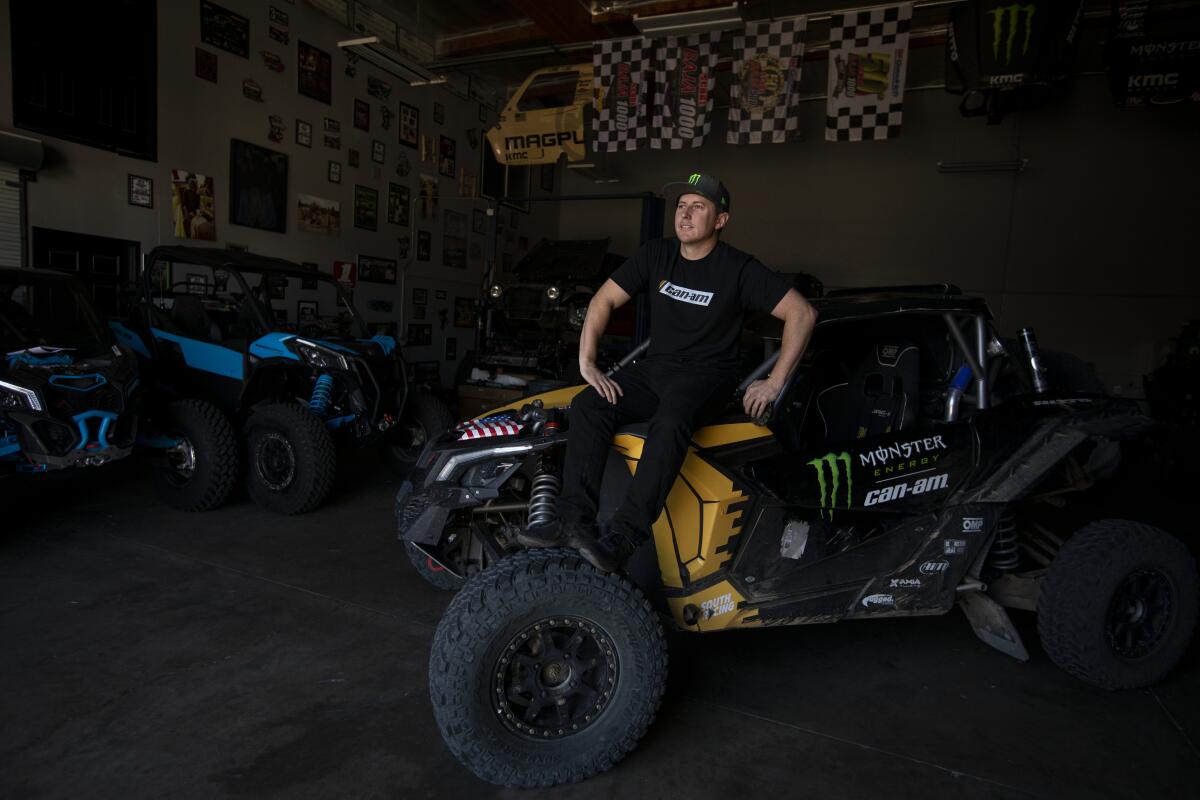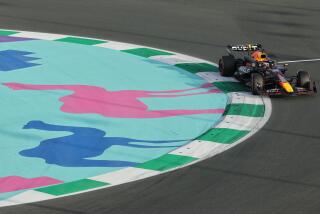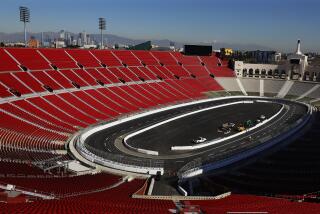Casey Currie hopes to make history at treacherous Dakar Rally in Saudi Arabia

Hordes of motorcycles, cars and trucks rumble across the desert, launching themselves over sand dunes, careening through dry washes and bouncing over stone roads. Drivers struggle to maintain control while navigating this wasteland with a map and compass.
“Rally raids” aren’t exactly left-turn racing on a paved oval. Picture a real-life version of “The Road Warrior,” then add some crucial mathematics.
And that’s what Casey Currie loves.
“You have no idea where you’re going … you have to figure it out,” Currie says. “Things can go wrong. You can drive off a cliff.”
The 36-year-old Corona man has devoted his life to off-road racing. Now he has a chance to make history in the renowned Dakar Rally.
More than 350 vehicles are expected to leave the starting line in Saudi Arabia on Sunday, embarking on a course that traverses 4,881 miles in 12 daily stages, beginning at the Red Sea and looping eastward toward the Persian Gulf.
“This is one of the biggest tests of man and machine on the planet,” says Parker Kligerman, a NASCAR veteran who will anchor NBC Sports Network’s coverage beginning Monday. “It’s incredibly complex.”
The Dakar Rally is also controversial.
Scores of racers, crew and spectators have died in its 40-year history. There are environmental concerns and political issues, with the event taking place for the first time in a country that has drawn global scorn. Currie chooses to focus on the finish line.
“No American has ever won it,” he says. “The challenge is there.”
::
His grandfather was an off-road racer. So was his father. For 60 years, his family has run a business that manufactures drive-train components.
So it makes sense that Currie took to riding dirt bikes at 5, then transitioned to jeeps as a teenager. As a student at Cal State Fullerton, he found time to race trucks for Nissan and, eventually, formed his own team.
“Definitely skipped the party days,” he says. “I was too busy trying to run a business on a shoestring budget.”
The unpredictable nature of off-road racing — varying surfaces, changing weather, navigational challenges — appealed to him. “Every sand dune is different,” he says.
His resume grew to include two-seat, high-tech dune buggies in the side-by-side vehicle, or SSV, class. After victories at the Baja 1000, Rallye du Maroc, Mint 400 and Winter X Games, he set his sights on a bigger prize.
Preparing for the Dakar Rally can take months and cost hundreds of thousands of dollars. Currie made his first attempt last year, when the event was held in South America.
Entered in the SSV class, he hired a Spaniard to ride beside him as navigator. His partner spoke only broken English and they got lost on several stages, wasting precious hours circling back, trying to find their bearings.
“A lot of navigation issues,” he recalls. “I mean, it was frustrating.”
But a fourth-place finish earned Currie the award for best rookie and encouraged him to try again. In a race that historically has had few American participants, he will compete alongside talented U.S. racers such as Bobby Patton in the car class and motorcycle riders Ricky Brabec and Andrew Short.
::
It was 1977 when a Frenchman named Thierry Sabine got lost while riding his motorcycle in the Libyan desert. The stark, arid landscape inspired him.
The event he created the following year drew nearly 200 racers. The Paris-Dakar Rally, as it was previously called, was named for a course that stretched from France to the capital city of Senegal.
In rally raids, drivers leave the starting line at staggered times, navigating by way of a daily “road book” that contains instructions bordering on cryptic. They must follow a compass heading for an exact number of kilometers, then turn to another heading for another stretch, and so on.

What is the Dakar Rally?
No road signs. Sporadic landmarks. No GPS devices allowed. Racers often must steer around obstacles and zigzag through valleys, finding their way back on course while accounting for the additional distance.
Periodic checkpoints offer some help: If drivers reach the correct spot, they receive a signal from computerized gear on their vehicle. If not, they must often retrace their routes.
“You could be going the right way and people are going the opposite way because they’re lost,” Currie says. “But you don’t really know if they’re lost or you are.”
The hard work continues after dark as crew members scramble to repair battered machinery, trying to keep their teams alive in a rally where, on a given year, one-third to three-quarters of competitors drop out before the finish.
“To win it, so often the racers talk about mixing those times when you go for speed and those times when you have to restrict yourself because the terrain is too grueling, too much risk,” Kligerman says. “It’s not just a sprint … the cunning riders and drivers will give up certain stages to make sure their bike or car survives for the next day.”

Road books for each stage are handed out the night before, affording little time to study. That only adds to the mystery.
“I think all the riders love to discover new deserts, new places,” Spanish motorcycle rider Laia Sanz says, adding that the 2020 venue “can go back to the origins a little bit.”
::
The Black Year. That is how organizers refer to 1986, when founder Sabine and four others perished in a helicopter crash while surveying the course.
Death has always been part of the Dakar Rally.
Twenty-eight competitors have been killed since 1978, according to various media accounts. Even more troubling, dozens of spectators and residents have been struck along the course. In 2006, a later stage was canceled after two boys died in separate incidents.
“The Paris-Dakar, a race which many classify as a sporting event, in reality has very little to do with healthy competition,” the Vatican newspaper L’Osservatore Romano wrote. “The trail of blood grows longer from year to year.”
Environmental concerns, raised by Greenpeace and others, center on damage wrought by all those vehicles tearing across the wilderness and, in one case, allegedly damaging an archaeological site.
Politics entered the mix in 2008, when organizers had to cancel at the last moment because of terrorist threats along the route in Mauritania. They shifted to South America for 11 years, then decided to move again this winter.
“The choice we made … was not an easy one,” rally executive Yann Le Moenner said at a recent news conference.
Human Rights Watch and other groups have accused Saudi Arabia of “sports washing,” hosting boxing and golf championships to rehabilitate its global image. The kingdom, which has been criticized for an array of human rights violations, including the murder of journalist Jamal Khashoggi, recently signed a five-year deal with Dakar organizers.
“More than a dozen women drivers will take part in the Dakar Rally while Saudi women activists languish in jail for promoting the right to drive,” Ines Osman, director of the MENA Rights Group, said in a statement. “Saudi Arabia should not get a free lane because it is hosting a prominent sporting event.”
Currie is aware of the criticism and has worried about his safety in the Middle East, where recent events in Iraq have heightened tensions. His decision to compete boiled down to a single thought.
“For me, this race is the one,” he says. “If I don’t compete in Saudi Arabia, then I’m not competing at all.”
::
The holidays were busy, devoted to testing and fine-tuning his Can-Am racing vehicle, fussing over the clutch and shocks and tire pressure. Physical fitness was also crucial.
“Obviously you’re going to the gym,” Currie said.
Dakar forced him to do even more, working with a specialist to improve his map-reading and strategic skills. More than anything, 12 days of hard driving will force him to keep his cool.
“I grew up racing one-day events where, if you have a bad day, you can get frustrated and lose your temper and go home,” he says. “Now I have to control myself.”
Limiting the damage on bad days and rebounding the next morning will be key. Currie hopes that new American co-driver Sean Berriman — “someone who speaks English” — will make a difference.
Arriving in Saudi Arabia last week, he made it through Thursday’s “scrutineering,” as race officials checked to be sure his vehicle met technical standards. On Friday, Currie and other competitors were allowed a brief “shakedown,” driving a portion of land outside the city of Jeddah.
The dirt roads and dunes gave them a sample of things to come. Just enough to get excited about.
“There’s so much desert and terrain,” he says. “It’s really the perfect opportunity to race.”
More to Read
Go beyond the scoreboard
Get the latest on L.A.'s teams in the daily Sports Report newsletter.
You may occasionally receive promotional content from the Los Angeles Times.











